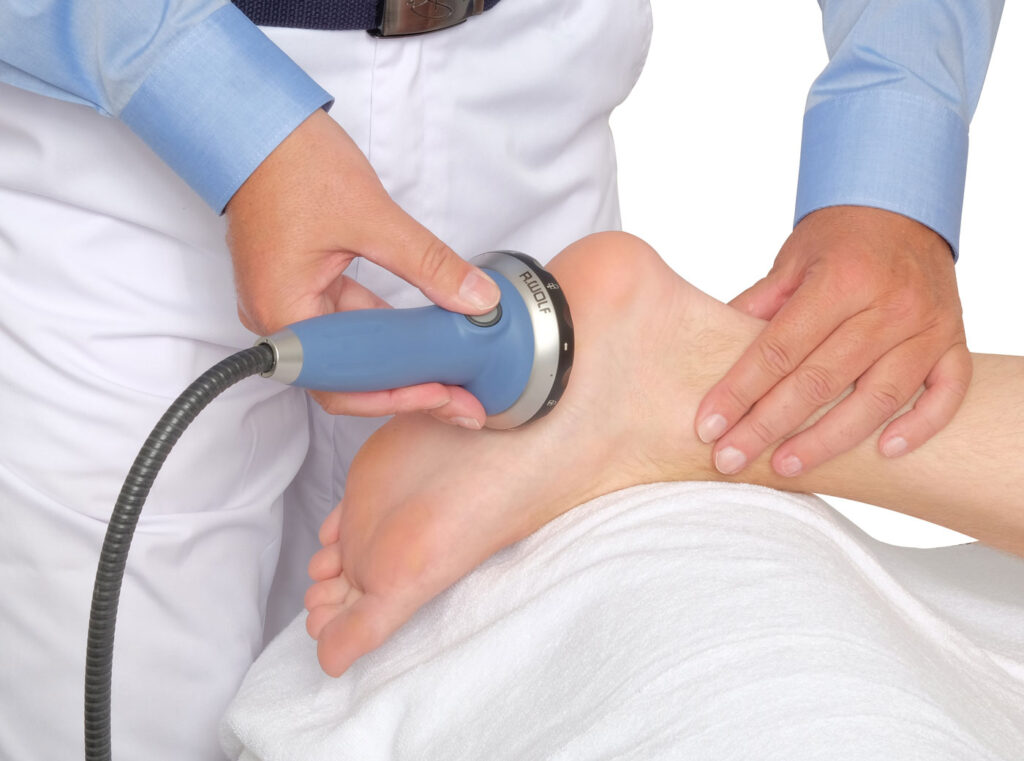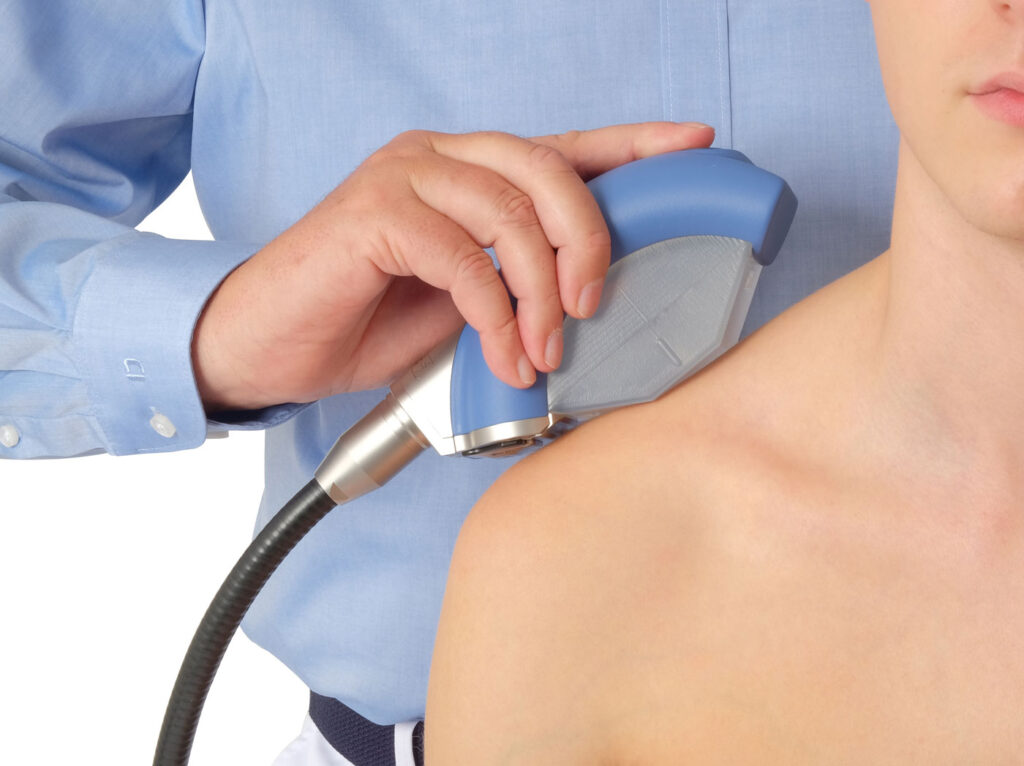


Myofascial Acoustic Compression Therapy (MyACT®™) is now available at The Back Alley Chiropractic & Massage
Myofascial Acoustic Compression Therapy (MyACT®™) is widely used in the treatment of acute and chronic pain in muscles, tendons and joints. MyACT describes the use of acoustic waves to target tissue at varying depths to compress and manipulate tissue resulting in a focused and precise deep tissue massage. The results of the mechanical stimulus delivered by MyACT can lead to increased circulation, range of motion and pain relief – key components in the healing process.
For targeted, non invasive pain relief
Mechanical stimuli affect almost all cellular functions of living tissue such as growth, cell differentiation, cell migration, protein synthesis, physiological apoptosis and tissue necrosis. The acoustic waves generated by the PiezoWave2 converge at a point deep within the soft tissue to produce an intense, extremely short duration compression burst. The focused acoustic compression force is translated to the surrounding tissue like an extremely precise deep tissue massage. The precise targeting of tissue with Acoustic Compression provides healthcare professionals with a tool to positively influence cellular form and function, which can result in pain relief and improved circulation.
Why PiezoWave2 and MyACT are Unique
Other companies providing compression devices to treat musculoskeletal conditions do not utilize sound waves to create the compression. These devices rely on a percussive application to the outer layer of soft tissue with the hope that the resulting pressure will translate through the tissue to the targeted injury. The deeper the targeted structure the higher the impact required to the outer soft tissue layer with diminishing clinical results due to pressure absorption and increased patient discomfort at the point of contact.
PiezoWave2 sends an array of sound waves effortlessly and without sensation through soft tissue to the desired, controlled depth and at that point the sound focuses to create the compression. This results in a more controlled and effective delivery of energy along with greater patient compliance to the therapy.
The two methods of delivery could not be more different and according to clinicians who have used both devices so are the clinical outcomes.
MyACT is not Ultrasound
Ultrasound units deliver thousands of pulses per second in order to vibrate soft tissue sufficient to produce a localized increase in soft tissue temperature. Unlike Ultrasound, the PiezoWave2 produces slow pulses that do not produce a thermal affect. In addition, the PiezoWave2’s slow sound pulses produce soft tissue compression and not soft tissue vibration
MyACT delivers mechanical energy – not light, electrical or thermal energy
Tenocytes in tendons, fibroblasts in ligaments and skin, osteocytes in bone, chondrocytes in articular cartilage and endothelial cells in blood vessels are mechano-sensitive and respond to mechanical forces.
MyACT targets tissue at varying depths to compress and manipulate tissue.
PiezoWave2 delivers the most energy precisely at the desired depth without being compromised by tissue absorption.
Conditions treatable with MyACT
A sound approach to treating acute and chronic musculoskeletal pain. Myofascial Acoustic Compression Therapy (MyACT) is widely used in the treatment of acute and chronic pain in muscles, tendons and joints. MyACT describes the use of acoustic waves to target tissue at varying depths to compress and manipulate tissue resulting in a focused and precise deep tissue massage. The results of the mechanical stimulus delivered by MyACT can lead to increased circulation and pain relief – key components in the healing process. MyACT is widely used in the musculosceletal system such as myofascial dysfunction and pain associated with triggerpoints.
Mechanism of Action
Acoustic pressure waves are characterized by a pressure surge with an extremely short rise time, which is then followed by an exponential drop in pressure and a brief phase of negative pressure. The pressure waves used in MyACT focus or develop in the target tissue at the point where the pain is originating from. The primary means by which pressure waves affect living tissue is based on the transformation of mechanical stimuli into biochemical or biomolecular signals. Described as mechanotransduction.
What patients can expect…
The acoustic waves generated by the PiezoWave2 therapy sources converge at a point deep within the soft tissue to produce an intense, extremely short duration pressure wave. This focused acoustic compression force is translated to the surrounding tissue like an extremely precise therapeutic deep tissue massage.
As the clinician identifies the treatment site(s), these will be charted for future treatments.
The clinician will then apply a thin coat of coupling gel. This gel helps to translate the acoustic sound waves generated by the therapy head to the body.
The clinician will start the treatment at a very low output setting and increase the power to a level that is tolerated by the patient and allows for definition of the treatment site. The output level and acoustic wave frequency rate may vary from location to location based on the depth and type of tissue being treated.
As the clinician moves the therapy source around the treatment area, the patient will feel a deep, dull ache that is familiar to the patient as being like the pain their condition produces. The clinician will ask the patient to report when he or she feels the ache and will adjust the output of the device to the appropriate level tolerated by the patient. The clinician will ask the patient to confirm that the therapy source is still creating the ache and may adjust the location of the treatment based on the patient’s feedback. If at anytime the treatment becomes uncomfortable, the patient is instructed to mention this to the clinician and the output is adjusted to a comfortable level.
After the treatment is completed, the coupling gel will be removed and the patient can return to their normal activities. The patient may experience some minor aches or discomfort after treatment. It is not unusual for patients to notice flushed or reddened skin around the treatment site.
How long does a course of treatment last?
A typical MyACT treatment takes between 10 and 20 minutes. Normally, 1-2 treatments per week are performed. A total of 3-5 treatments for acute conditions, and 10-12 for chronic conditions, may be necessary before lasting improvement is achieved.